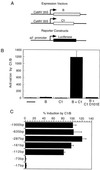Activation of the maize anthocyanin gene a2 is mediated by an element conserved in many anthocyanin promoters
- PMID: 9625696
- PMCID: PMC34963
- DOI: 10.1104/pp.117.2.437
Activation of the maize anthocyanin gene a2 is mediated by an element conserved in many anthocyanin promoters
Abstract
Two transcription factors, C1 (a Myb-domain protein) and B (a basic-helix-loop-helix protein), mediate transcriptional activation of the anthocyanin-biosynthetic genes of maize (Zea mays). To begin to assess the mechanism of activation, the sequences required for C1- and B-mediated induction have been determined for the a2 promoter, which encodes an anthocyanin-biosynthetic enzyme. Analysis of a series of 7- to 13-base-pair substitutions revealed two regions crucial for activation. One region, centered at -99, contained a C1-binding site that abolished C1 binding. The other crucial region was adjacent, centered at -91. C1 binding was not detected at this site, and mutation of this site did not prevent C1 binding at -99. An oligonucleotide dimer containing these two crucial elements was sufficient for C1 and B activation of a heterologous promoter. These data suggest that activation of the anthocyanin genes involves C1 and another factor binding at closely adjacent sites. Mutating a previously postulated anthocyanin consensus sequence within a2 did not significantly reduce activation by C1 and B. However, sequence comparisons of the crucial a2 regions with sequences important for C1- and B-mediated activation in two other anthocyanin promoters led to a revised consensus element shared by these promoters.
Figures






Similar articles
-
Functional analysis of the transcriptional activator encoded by the maize B gene: evidence for a direct functional interaction between two classes of regulatory proteins.Genes Dev. 1992 May;6(5):864-75. doi: 10.1101/gad.6.5.864. Genes Dev. 1992. PMID: 1577278
-
The Viviparous-1 gene and abscisic acid activate the C1 regulatory gene for anthocyanin biosynthesis during seed maturation in maize.Genes Dev. 1992 Apr;6(4):609-18. doi: 10.1101/gad.6.4.609. Genes Dev. 1992. PMID: 1532784
-
Analysis of bHLH and MYB domain proteins: species-specific regulatory differences are caused by divergent evolution of target anthocyanin genes.Plant J. 1998 Feb;13(4):475-88. doi: 10.1046/j.1365-313x.1998.00046.x. Plant J. 1998. PMID: 9680994
-
Maize anthocyanin regulatory gene pl is a duplicate of c1 that functions in the plant.Plant Cell. 1993 Dec;5(12):1795-805. doi: 10.1105/tpc.5.12.1795. Plant Cell. 1993. PMID: 8305872 Free PMC article.
-
Recent advances on the regulation of anthocyanin synthesis in reproductive organs.Plant Sci. 2011 Sep;181(3):219-29. doi: 10.1016/j.plantsci.2011.05.009. Epub 2011 Jun 12. Plant Sci. 2011. PMID: 21763532 Review.
Cited by
-
Regulatory switch enforced by basic helix-loop-helix and ACT-domain mediated dimerizations of the maize transcription factor R.Proc Natl Acad Sci U S A. 2012 Jul 24;109(30):E2091-7. doi: 10.1073/pnas.1205513109. Epub 2012 Jul 9. Proc Natl Acad Sci U S A. 2012. PMID: 22778424 Free PMC article.
-
Structure and evolution of the r/b chromosomal regions in rice, maize and sorghum.Genetics. 2005 Feb;169(2):891-906. doi: 10.1534/genetics.104.034629. Epub 2004 Oct 16. Genetics. 2005. PMID: 15489523 Free PMC article.
-
Activation of anthocyanin biosynthesis in Gerbera hybrida (Asteraceae) suggests conserved protein-protein and protein-promoter interactions between the anciently diverged monocots and eudicots.Plant Physiol. 2003 Dec;133(4):1831-42. doi: 10.1104/pp.103.026039. Epub 2003 Nov 6. Plant Physiol. 2003. PMID: 14605235 Free PMC article.
-
Two basic-helix-loop-helix genes (MYC-146 and GL3) from Arabidopsis can activate anthocyanin biosynthesis in a white-flowered Matthiola incana mutant.Plant Mol Biol. 2003 Jun;52(3):679-88. doi: 10.1023/a:1024852021124. Plant Mol Biol. 2003. PMID: 12956536
-
Identification of Transcription Factors ZmMYB111 and ZmMYB148 Involved in Phenylpropanoid Metabolism.Front Plant Sci. 2016 Feb 15;7:148. doi: 10.3389/fpls.2016.00148. eCollection 2016. Front Plant Sci. 2016. PMID: 26913047 Free PMC article.
References
-
- Bodeau JP, Walbot V. Structure and regulation of the maize Bronze2 promoter. Plant Mol Biol. 1996;32:599–609. - PubMed
-
- Dooner HK, Robbins TP, Jorgensen RA. Genetic and developmental control of anthocyanin biosynthesis. Annu Rev Genet. 1991;25:173–199. - PubMed
-
- Goff SA, Cone KC, Chandler VL. Functional analysis of the transcriptional activator encoded by the maize B gene: evidence for a direct functional interaction between two classes of regulatory proteins. Genes Dev. 1992;6:864–875. - PubMed
-
- Goff SA, Cone KC, Fromm ME. Identification of functional domains in the maize transcriptional activator C1: comparison of wild-type and dominant inhibitor proteins. Genes Dev. 1991;5:298–309. - PubMed
Publication types
MeSH terms
Substances
Grants and funding
LinkOut - more resources
Full Text Sources
Other Literature Sources

